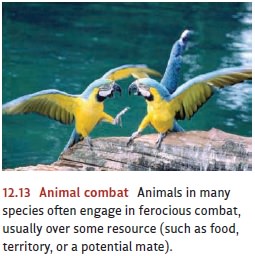Chapter: Psychology: Motivation and Emotion
Physiological Aspects of Threat and Aggression
Physiological Aspects of Threat and Aggression
What
physiological mechanisms underlie our reactions to threat? One crucial
mecha-nism is the sympathetic branch of the autonomic nervous system. This
branch summons the body’s resources in times of crisis and gets the organism
ready for vigorous action. We have mentioned some of the effects of sympathetic
excitation, but in addition, this excitation stimulates the inner core of the
adrenal gland, the adrenal medulla, to pour epinephrine (adrenaline) and
norepinephrine into the bloodstream. These chemicals have effects similar to
activation of the sympathetic nervous system— they accelerate the heart rate,
speed up metabolism, and so on. As a result, they amplify sympathetic effects
even further.
THE “ FIGHT OR FLIGHT ”RESPONSE
The
physiologist Walter Cannon argued that intense sympathetic arousal serves as an
emergency reaction that mobilizes the organism for a crisis—for “fight or
flight,” as he described it. Consider a grazing zebra, placidly maintaining
homeostasis by nibbling at the grass and vasodilating in the hot African sun.
Suddenly it sees a lion closing in for the kill. Escape will require pronounced
muscular exertion, with the support of the entire bodily machinery, and this is
exactly what intense sympathetic activation pro-vides. Because of this
activation, more nutrient fuel is available to the muscles and can be delivered
rapidly through wide-open blood vessels. At the same time, waste products are
jettisoned and all less-essential bodily activities are brought to a halt.
Cannon
produced considerable evidence suggesting that a similar autonomic reac-tion
occurs when an organism prepares to attack rather than flee. A cat about to
tangle with a dog shows accelerated heartbeat, piloerection (its hair standing
on end, normally a heat-conserving device), and pupillary dilation—all signs of
sympathetic arousal that show the body is girding itself for violent muscular
effort (Figure 12.11).

It
turns out, however, that Cannon’s “fight or flight” formulation is overly
simple, because organisms respond to threat in many different ways. While it is
true that in some contexts, animals do indeed fight or flee, in other contexts,
animals may stand immobile when threatened, so that predators are less likely
to notice them. Other ani-mals have more exotic means of self-protection. For
example, some species of fish pale when threatened, which makes them harder to spot
against the sandy ocean bottom. This effect results from the direct action of
adrenal epinephrine on various pigments in the animal’s skin (Odiorne, 1957).
A
further complication for Cannon’s formulation comes from variations within aspecies. For example, Taylor and
colleagues noted that most studies of the stressresponse had been conducted
using male rats or humans (S. E. Taylor et al., 2000; S. E. Taylor, 2006). When
researchers examined females’ responses, they found that their responses did
not fit the “fight or flight” pattern of response. For example, women seemed to
respond to stressful situations by “tending” (i.e., taking care of children)
and “befriending” (i.e., using social support) (Figure 12.12).

These
limitations notwithstanding, the mechanism Cannon highlighted—an emer-gency
system rooted in the sympathetic nervous system—is essential for many
individ-uals in many species. At the same time, however, arousal of the
sympathetic branch of the ANS can be disruptive and even damaging. This is
especially clear in humans. In our day-to-day lives, we rarely encounter
emergencies that call for violent physical effort, but our biological nature
has not completely changed just because the modern world contains no threats
from saber-toothed tigers. We are plagued instead by chronic stres-sors like
traffic jams, ornery bosses, pressing deadlines, and agonizing world crises.
Although we often feel impelled to defend ourselves against these threats of
the mod-ern world, physical action is frequently inappropriate, ineffective, or
illegal. Nonetheless, we are stuck with the same emergency reactions that our
ancestors had, and so we keep ourselves armed physiologically against
situations we cannot really con-trol. The resulting bodily wear and tear can
take a serious toll (e.g., Sapolsky, 1998).
AGGRESSION AND PREDATION
It
seems, then, that our biological reaction to threat may not always serve us well
in our modern environment. Nonetheless, this reaction is well rooted in our
biology, and it is certainly similar to the reaction pattern easily observed in
many other species. It is a reaction pattern that has been shaped by natural
selection and that has, over each species’ history, contributed to survival by
preparing the organism for whatever ener-getic activities it needs to escape
the threat.
But
what does the animal do once the emergency reaction is under way? Are the
subsequent steps also shared across species? To answer this question, it is
helpful to draw on the comparative
method, studying nonhumans as well as humans to see what kinds of
commonalities in our behavior reflect shared biological heritage.
As
a first and crucial point, though, we need to distinguish two forms of violence
that organisms engage in—aggression
and predation. Predators hunt and
kill for food, but they do so quite dispassionately. A predator about to pounce
on its prey shows none of the signs of anger, and so a dog on the verge of
catching a rabbit never growls, nor does it have its ears laid back (K. Z.
Lorenz, 1966). Predatory attack is instead moti-vated by hunger, and it is
controlled by the same brain sites as eating (Hutchinson & Renfrew, 1966).
In contrast, aggressive or self-defense behaviors are controlled by dis-tinct
brain areas, are triggered by different situations, and certainly show
different behavioral profiles. In our discussion of aggression, therefore, it
will be best to hold predatory attack to the side—as part of an animal’s
food-gathering repertoire, and not part of its response to threat.
MALE AGGRESSION AND HORMONES
Genuine
combat is, in fact, widespread among animals, and there is probably no species
that has forsworn aggression altogether (Figure 12.13). Fish chase and nip each
other; lizards lunge and push; birds attack with wing , beak, and claw; and on
and on. In most cases, the individuals we identify as aggressive are male,
because, among vertebrates, the male is by far the more physically aggressive
sex. In some mammals, this sex difference in combativeness is apparent even in
childhood play. Young male rhesus monkeys, for instance, engage in much more
vigorous rough-and-tumble play than their sisters (Harlow, 1962). Among humans,
boys worldwide are more physically aggressive than girls (Geary &
Bjorklund, 2000), and as adults, male murderers outnumber females by a ratio of
10:1 (C. A. Anderson & Bushman, 2002).


However,
this gender difference holds only for physical
aggression. Human females are also aggressive, but their aggression tends to
rely on verbal or social assaults, not physical violence. Thus, females attack
by means of insults or the spreading of rumors; they take steps to isolate
someone from friends and allies (Figure 12.14). If we focus on these sorts of
aggression, then it is women, not men, who are the aggressive sex (Oesterman et
al., 1998).
Why
is physical aggression so much more prevalent in men? Biological factors are
clearly relevant, because aggression is partially influenced by hormones,
particularly the sex hormone testosterone.
High testosterone levels in the bloodstream are associated with increased
physical aggressiveness in many different species, including fish, lizards,
turtles, birds, rats, mice, and monkeys (D. E. Davis, 1964; A. Siegel &
Demetrikopoulos, 1993). However, the relationship between testosterone and
physical aggression is com-plex. As one complication, at least some human
aggression bears no relationship to testos-terone levels, so it must be shaped
by other factors (e.g., Book, Starzyk, & Qunisey, 2001). In addition, high
testosterone levels can be both a cause and an effect of aggressive behav-ior.
Thus, testosterone administered externally can increase subsequent
aggressiveness, but successful aggressive encounters can also cause increased
secretion of testosterone (Dabbs, 1992; Rosenzweig, Leiman, & Breedlove,
1996; Sapolsky, 1998).
Related Topics